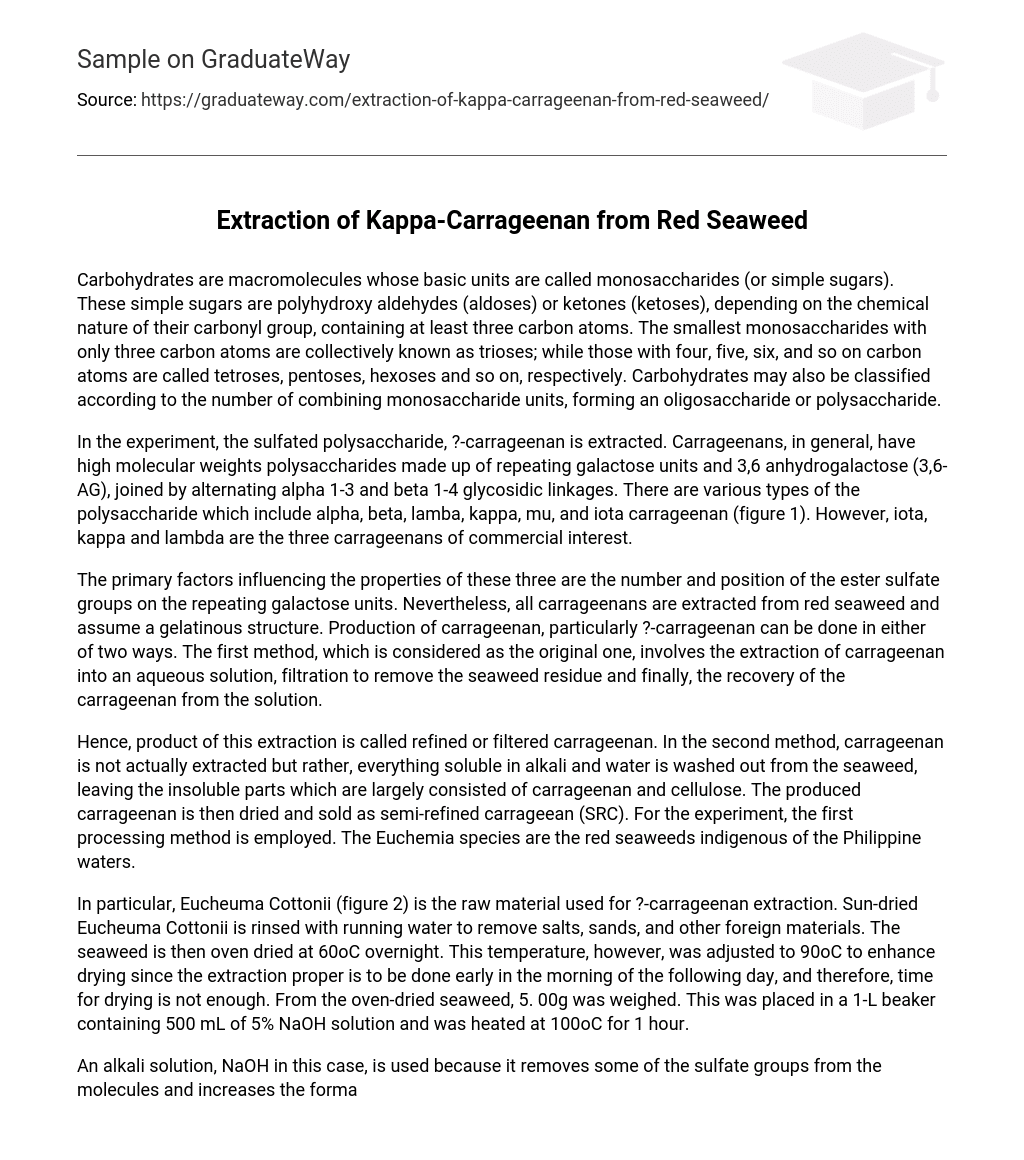Carbohydrates are large molecules made up of monosaccharides or simple sugars. Monosaccharides can be aldehydes (aldoses) or ketones (ketoses), depending on their carbonyl group. They have a minimum of three carbon atoms. Trioses are the smallest monosaccharides with three carbon atoms, while tetroses, pentoses, hexoses, and so on indicate those with four, five, six, and more carbon atoms respectively. Carbohydrates can also be classified based on the number of monosaccharide units they contain and form either an oligosaccharide or polysaccharide.
The extraction of ?-carrageenan is conducted as part of an experiment. Carrageenans, such as alpha, beta, lamba, kappa, mu, and iota carrageenan (figure 1), are sulfated polysaccharides with high molecular weights. They consist of repeating galactose units and 3,6 anhydrogalactose (3,6-AG), connected by alternating alpha 1-3 and beta 1-4 glycosidic linkages. Among these carrageenans, iota, kappa, and lambda are the commercially important ones.
The properties of these three depend on the number and position of the ester sulfate groups on the repeating galactose units. However, all carrageenans come from red seaweed and have a gelatinous structure. There are two methods to produce carrageenan, especially ?-carrageenan. The first method, considered the original, involves extracting carrageenan into an aqueous solution, filtering out the seaweed residue, and recovering the carrageenan from the solution.
The process known as extraction produces a refined or filtered carrageenan. In another method, the carrageenan is not extracted but instead, all substances soluble in alkali and water are washed away from the seaweed, leaving behind the insoluble components, which mainly consist of carrageenan and cellulose. This resulting carrageenan is then dried and sold as semi-refined carrageean (SRC). For this experiment, the first processing method is utilized. The Euchemia species are red seaweeds native to the Philippine waters.
In particular, the extraction of ?-carrageenan uses Eucheuma Cottonii as its raw material (figure 2). The Eucheuma Cottonii is first rinsed with running water to eliminate salts, sands, and other foreign materials. It is then dried in an oven at 60oC overnight. However, the drying temperature was increased to 90oC to expedite the process since the extraction will take place early the next morning and there is limited time for drying. 5.00g of the oven-dried seaweed is weighed and placed in a 1-L beaker with 500 mL of 5% NaOH solution. It is then heated at 100oC for 1 hour.
NaOH, an alkali solution, is employed to enhance the gel strength of the final product by eliminating sulfate groups from the molecules and promoting the formation of 3,6-AG. Afterwards, the solution is subjected to suction filtration to extract undissolved seaweeds and boost carrageenan concentration from 1-2% to 2-3%. Isopropyl alcohol is then introduced to the filtrate until precipitation occurs, which is subsequently followed by a 24-hour freeze drying of the resulting precipitate.
This process involves recovering carrageenan as a fibrous coagulum through the alcohol method. Alcohol acts as a dehydrating agent, removing the solvent from the carrageenan. The gel method, however, can only be used for recovering kappa-carrageenan, relying on its ability to form a gel with potassium salts. Dehydration of the gel can be achieved through either a freeze-thaw process or squeezing it under pressure. The schematic diagram in figure 3 illustrates the refined carrageenan process. To characterize the extracted kappa-carrageenan, it can be analyzed using an Ostwald viscometer for determining its average molecular weight through viscosity measurement. Additionally, IR spectroscopy can provide information about the carrageenan’s structure, particularly since sulfated polysaccharides exhibit strong, broad absorption bands in the 1000-1100 cm-1 region.
Further characterization of carrageenan can also be achieved through qualitative tests for carbohydrates. These tests include Molisch’s, Bial’s, Seliwanoff’s, Benedict’s, Barfoed’s, Mucic acid, hydrolysis of polysaccharides, and iodine test. Each test provides information on the nature and properties of the polysaccharide. The first three tests are based on the production of furfural and furfural derivatives, while the other four tests are based on the reactivity of the aldehyde or potential aldehyde group. However, in the experiment, characterization of the extracted ?-carrageenan was not performed.





